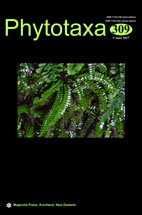Abstract
The Neotropical genus Caucaea Schlechter (1920: 190) was established based on a small-flowered Colombian species, C. obscura (Lehm. & Krenzl. in Kränzlin 1899: 488) Schlechter (1920: 190) originally described as representative of Rodriguezia Ruiz López & Pavón (1794: 115, t. 25). In 1934, Mansfeld revealed that previously discovered Abola radiata Lindley (1853: 1) is a synonym of Schlechter’s C. obscura. Since the generic name Abola was used earlier by Adanson (1763) for a genus of Poaceae, he proposed to synonymize C. obscura with A. radiata under name Caucaea radiata (Lindl.) Mansfeld (1934: 343). Since this publication the genus had been considered monospecific until Williams et al. (2001) published surprising results of molecular research. According to their study, C. radiata is embedded in clade composed of representatives of Oncidium section Cucullata Kränzlin (1922: 128), which are large-flowered plants. In both C. radiata and Oncidium section Cucullata the lateral sepals are partially connate, the lip callus is rather simple and the gynostemium morphology is similar. The composition of Caucaea was later confirmed by Neubig et al. (2012).

